Work, Energy, Power and Collision
Table of Contents
Work, Power, and the Work–Energy Theorem
In physics, the term work has a very specific definition. Work is application of force, f, to move an object over a distance, d, in the direction that the force is applied. Work, W, is described by the equation
W = fd
Some things that we typically consider to be work are not work in the scientific sense of the term. Let’s consider a few examples. Think about why each of the following statements is true.
- Homework is not work.
- Lifting a rock upwards off the ground is work.
- Carrying a rock in a straight path across the lawn at a constant speed is not work.
The first two examples are fairly simple. Homework is not work because objects are not being moved over a distance. Lifting a rock up off the ground is work because the rock is moving in the direction that force is applied. The last example is less obvious. From the laws of motion , we know that that force is not required to move an object at constant velocity. Therefore, while some force may be applied to keep the rock up off the ground, no net force is applied to keep the rock moving forward at constant velocity.
Work and energy are closely related. When you do work to move an object, you change the object’s energy. You (or an object) also expend energy to do work. In fact, energy can be defined as the ability to do work. Energy can take a variety of different forms, and one form of energy can transform to another. In this chapter we will be concerned with mechanical energy, which comes in two forms: kinetic energy and potential energy.
- Kinetic energy is also called energy of motion. A moving object has kinetic energy.
- Potential energy, sometimes called stored energy, comes in several forms. Gravitational potential energy is the stored energy an object has as a result of its position above Earth’s surface (or another object in space). A roller coaster car at the top of a hill has gravitational potential energy.
Let’s examine how doing work on an object changes the object’s energy. If we apply force to lift a rock off the ground, we increase the rock’s potential energy, PE. If we drop the rock, the force of gravity increases the rock’s kinetic energy as the rock moves downward until it hits the ground.
The force we exert to lift the rock is equal to its weight, w, which is equal to its mass, m, multiplied by acceleration due to gravity, g.

The work we do on the rock equals the force we exert multiplied by the distance, d, that we lift the rock. The work we do on the rock also equals the rock’s gain in gravitational potential energy, PEe.

Kinetic energy depends on the mass of an object and its velocity, v.
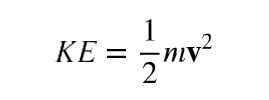
When we drop the rock the force of gravity causes the rock to fall, giving the rock kinetic energy. When work done on an object increases only its kinetic energy, then the net work equals the change in the value of the quantity 1/2 mv2. This is a statement of the work–energy theorem, which is expressed mathematically as

The subscripts 2 and 1 indicate the final and initial velocity, respectively. This theorem was proposed and successfully tested by James Joule
The joule (J) is the metric unit of measurement for both work and energy. The measurement of work and energy with the same unit reinforces the idea that work and energy are related and can be converted into one another. 1.0 J = 1.0 N∙m, the units of force multiplied by distance. 1.0 N = 1.0 k∙m/s2, so 1.0 J = 1.0 k∙m2/s2. Analyzing the units of the term (1/2)mv2 will produce the same units for joules.
Calculations Involving Work and Power
In applications that involve work, we are often interested in how fast the work is done. For example, in roller coaster design, the amount of time it takes to lift a roller coaster car to the top of the first hill is an important consideration. Taking a half hour on the ascent will surely irritate riders and decrease ticket sales. Let’s take a look at how to calculate the time it takes to do work.
Recall that a rate can be used to describe a quantity, such as work, over a period of time. Power is the rate at which work is done. In this case, rate means per unit of time. Power is calculated by dividing the work done by the time it took to do the work.
P = W / t
Power can be expressed in units of watts (W). This unit can be used to measure power related to any form of energy or work. You have most likely heard the term used in relation to electrical devices, especially light bulbs. Multiplying power by time gives the amount of energy. Electricity is sold in kilowatt-hours because that equals the amount of electrical energy consumed.
Mechanical Energy and Conservation of Energy
We saw earlier that mechanical energy can be either potential or kinetic. In this section we will see how energy is transformed from one of these forms to the other. We will also see that, in a closed system, the sum of these forms of energy remains constant.
Imagine a roller coaster ride . Quite a bit of potential energy is gained by a roller coaster car and its passengers when they are raised to the top of the first hill. Remember that the potential part of the term means that energy has been stored and can be used at another time. You will see that this stored energy can either be used to do work or can be transformed into kinetic energy. For example, when an object that has gravitational potential energy falls, its energy is converted to kinetic energy. Remember that both work and energy are expressed in joules.
Now, let’s look at the roller coaster in the below figure . Work was done on the roller coaster to get it to the top of the first rise; at this point, the roller coaster has gravitational potential energy. It is moving slowly, so it also has a small amount of kinetic energy. As the car descends the first slope, its PE is converted to KE. At the low point much of the original PE has been transformed to KE, and speed is at a maximum. As the car moves up the next slope, some of the KE is transformed back into PE and the car slows down.
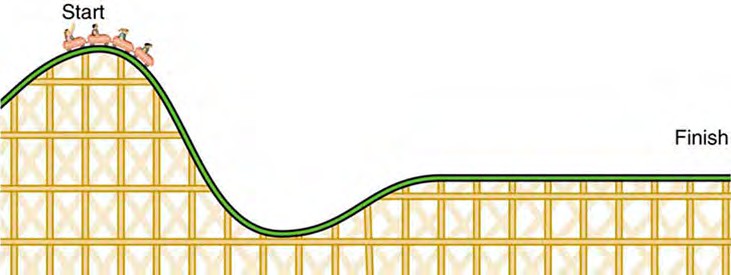
On an actual roller coaster, there are many ups and downs, and each of these is accompanied by transitions between kinetic and potential energy. Assume that no energy is lost to friction. At any point in the ride, the total mechanical energy is the same, and it is equal to the energy the car had at the top of the first rise. This is a result of the law of conservation of energy, which says that, in a closed system, total energy is conserved—that is, it is constant. Using subscripts 1 and 2 to represent initial and final energy, this law is expressed as

Either side equals the total mechanical energy. The phrase in a closed system means we are assuming no energy is lost to the surroundings due to friction and air resistance. If we are making calculations on dense falling objects, this is a good assumption.
Elastic and Inelastic Collisions
When objects collide, they can either stick together or bounce off one another, remaining separate. In this section, we’ll cover these two different types of collisions, first in one dimension and then in two dimensions.
In an elastic collision, the objects separate after impact and don’t lose any of their kinetic energy. Kinetic energy is the energy of motion and is covered in detail elsewhere. The law of conservation of momentum is very useful here, and it can be used whenever the net external force on a system is zero. The below figure shows an elastic collision where momentum is conserved
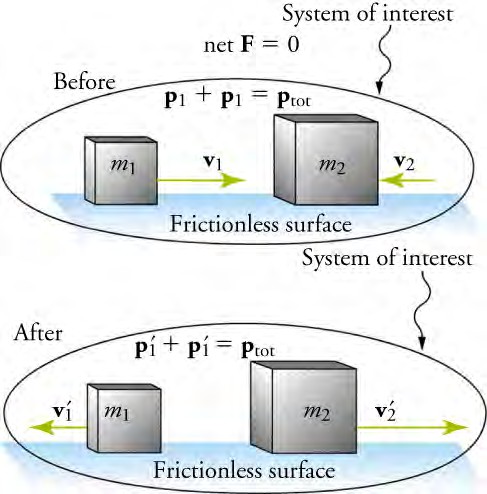
Perfectly elastic collisions can happen only with subatomic particles. Everyday observable examples of perfectly elastic collisions don’t exist—some kinetic energy is always lost, as it is converted into heat transfer due to friction. However, collisions between everyday objects are almost perfectly elastic when they occur with objects and surfaces that are nearly frictionless, such as with two steel blocks on ice.
Now, to solve problems involving one-dimensional elastic collisions between two objects, we can use the equation for conservation of momentum. First, the equation for conservation of momentum for two objects in a one-dimensional collision is

Substituting the definition of momentum p = mv for each initial and final momentum, we get

where the primes (‘) indicate values after the collision; In some texts, you may see i for initial (before collision) and f for final (after collision). The equation assumes that the mass of each object does not change during the collision
Now, let us turn to the second type of collision. An inelastic collision is one in which objects stick together after impact, and kinetic energy is not conserved. This lack of conservation means that the forces between colliding objects may convert kinetic energy to other forms of energy, such as potential energy or thermal energy. The concepts of energy are discussed more thoroughly elsewhere. For inelastic collisions, kinetic energy may be lost in the form of heat. Below figure shows an example of an inelastic collision. Two objects that have equal masses head toward each other at equal speeds and then stick together. The two objects come to rest after sticking together, conserving momentum but not kinetic energy after they collide. Some of the energy of motion gets converted to thermal energy, or heat.
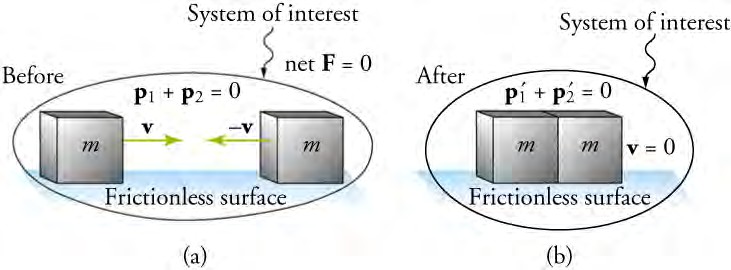
The figure shows A one-dimensional inelastic collision between two objects. Momentum is conserved, but kinetic energy is not conserved. (a) Two objects of equal mass initially head directly toward each other at the same speed. (b) The objects stick together, creating a perfectly inelastic collision. In the case shown in this figure, the combined objects stop; This is not true for all inelastic collisions.
Since the two objects stick together after colliding, they move together at the same speed. This lets us simplify the conservation of momentum equation from

to

for inelastic collisions, where v′ is the final velocity for both objects as they are stuck together, either in motion or at rest.
But what about collisions, such as those between billiard balls, in which objects scatter to the side? These are two-dimensional collisions, and just as we did with two- dimensional forces, we will solve these problems by first choosing a coordinate system and separating the motion into its x and y components.
We start by assuming that Fnet = 0, so that momentum p is conserved. The simplest collision is one in which one of the particles is initially at rest. The best choice for a coordinate system is one with an axis parallel to the velocity of the incoming particle, as shown in below figure . Because momentum is conserved, the components of momentum along the x– and y-axes, displayed as px and py, will also be conserved. With the chosen coordinate system, py is initially zero and px is the momentum of the incoming particle.
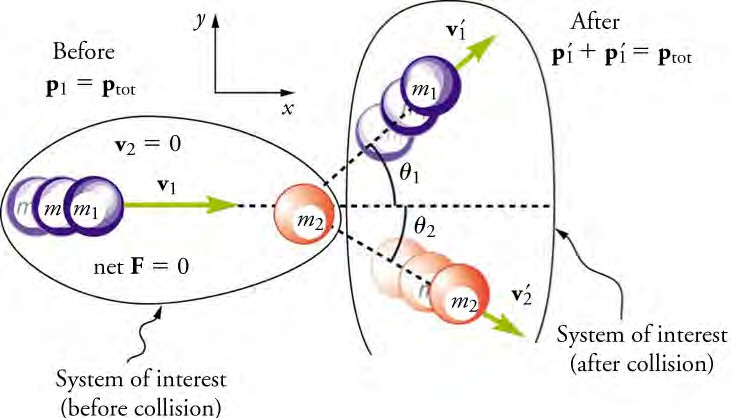
Now, we will take the conservation of momentum equation, p1 + p2 = p′1 + p′2 and break it into its x and y components. Along the x-axis, the equation for conservation of momentum is

In terms of masses and velocities, this equation is

But because particle 2 is initially at rest, this equation becomes

The components of the velocities along the x-axis have the form v cos θ . Because particle 1 initially moves along the x-axis, we find v1x = v1. Conservation of momentum along the x-axis gives the equation

where θ1 and θ2 are as shown in the above Figure
Along the y-axis, the equation for conservation of momentum is

or

But v1y is zero, because particle 1 initially moves along the x-axis. Because particle 2 is initially at rest, v2y is also zero. The equation for conservation of momentum along the y-axis becomes

The components of the velocities along the y-axis have the form v sin θ . Therefore, conservation of momentum along the y-axis gives the following equation:

(You can access this textbook for free in web view or PDF through OpenStax.org, and for a low cost in print)
Take Quiz
1) Describe the transformation between forms of mechanical energy that is happening to a falling skydiver before his parachute opens.
a. Kinetic energy is being transformed into potential energy.
b. Potential energy is being transformed into kinetic energy.
c. Work is being transformed into kinetic energy.
d. Kinetic energy is being transformed into work.
ANSWER
b. Potential energy is being transformed into kinetic energy.
2) True or false—If a rock is thrown into the air, the increase in the height would increase the rock’s kinetic energy, and then the increase in the velocity as it falls to the ground would increase its potential energy.
a. True
b. False
ANSWER
b. False
3) A 0.2 kg apple on an apple tree has a potential energy of 10 J. It falls to the ground, converting all of its PE to kinetic energy. What is the velocity of the apple just before it hits the ground?
a. 0 m/s
b. 2 m/s
c. 10 m/s
d. 50 m/s
ANSWER
c. 10 m/s
4) Is it possible for the sum of kinetic energy and potential energy of an object to change without work having been done on the object? Explain.
A) No, because the work-energy theorem states that work done on an object is equal to the change in kinetic energy, and change in KE requires a change in velocity. It is assumed that mass is constant.
b) No, because the work-energy theorem states that work done on an object is equal to the sum of kinetic energy, and the change in KE requires a change in displacement. It is assumed that mass is constant.
C) Yes, because the work-energy theorem states that work done on an object is equal to the change in kinetic energy, and change in KE requires a change in velocity. It is assumed that mass is constant.
D)Yes, because the work-energy theorem states that work done on an object is equal to the sum of kinetic energy, and the change in KE requires a change in displacement. It is assumed that mass is constant
ANSWER
D) Yes, because the work-energy theorem states that work done on an object is equal to the sum of kinetic energy, and the change in KE requires a change in displacement. It is assumed that mass is constant
5) The starting line of a cross country foot race is at the bottom of a hill. Which form(s) of mechanical energy of the runners will change when the starting gun is fired?
a. Kinetic energy only
b. Potential energy only
c. Both kinetic and potential energy
d. Neither kinetic nor potential energy
ANSWER
c. Both kinetic and potential energy
6) True or false—A cyclist coasts down one hill and up another hill until she comes to a stop. The point at which the bicycle stops is lower than the point at which it started coasting because part of the original potential energy has been converted to a quantity of heat and this makes the tires of the bicycle warm.
a. True
b. False
ANSWER
b. False
7) A boy pushes his little sister on a sled. The sled accelerates from 0 to 3.2 m/s . If the combined mass of his sister and the sled is 40.0 kg and 18 W of power were generated, how long did the boy push the sled?
a. 205 s
b. 128 s
c. 23 s
d. 11 s
ANSWER
c. 23 s
8) What is the kinetic energy of a bullet traveling at a velocity of ?
a. 3.5 L
b. 7J
c. 2.45 x 103 J
d. 2.45 x 105 J
ANSWER
c. 2.45 x 103 J
9) A marble rolling across a flat, hard surface at rolls up a ramp. Assuming that and no energy is lost to friction, what will be the vertical height of the marble when it comes to a stop before rolling back down? Ignore effects due to the rotational kinetic energy.
a. 0.1 m
b. 0.2 m
c. 0.4 m
d. 2 m
ANSWER
b. 0.2 m
10) The work–energy theorem states that the change in the kinetic energy of an object is equal to what?
a. The work done on the object
b. The force applied to the object
c. The loss of the object’s potential energy
d. The object’s total mechanical energy minus its kinetic energy
ANSWER
a. The work done on the object
11) A runner at the start of a race generates 250 W of power as he accelerates to 5 m/s . If the runner has a mass of 60 kg, how long did it take him to reach that speed?
a. 0.33 s
b. 0.83 s
c. 1.2 s
d. 3.0 s
ANSWER
d. 3.0 s
12) A car’s engine generates 100,000 W of power as it exerts a force of 10,000 N. How long does it take the car to travel 100 m?
a. 0.001 s
b. 0.01 s
c. 10 s
d. 1,000 s
ANSWER
c. 10 s
13) Why is this expression for kinetic energy incorrect?
KE = (m) (v) 2
a. The constant is missing.
b. The term should not be squared.
c. The expression should be divided by 2 .
d. The energy lost to friction has not been subtracted
ANSWER
c. The expression should be divided by 2 .
14) What is the kinetic energy of a 10kg object moving at 2.0 m/s ?
a. 10 J
b. 20 J
c. 40 J
d. 100 J
ANSWER
b. 20 J
15) A boulder rolls from the top of a mountain, travels across a valley below, and rolls part way up the ridge on the opposite side. Describe all the energy transformations taking place during these events and identify when they happen.
a. As the boulder rolls down the mountainside, KE is converted to PE. As the boulder rolls up the opposite slope, PE is converted to KE. The boulder rolls only partway up the ridge because some of the PE has been converted to thermal energy due to friction.
b. As the boulder rolls down the mountainside, KE is converted to PE. As the boulder rolls up the opposite slope, KE is converted to PE. The boulder rolls only partway up the ridge because some of the PE has been converted to thermal energy due to friction.
c. As the boulder rolls down the mountainside, PE is converted to KE. As the boulder rolls up the opposite slope, PE is converted to KE. The boulder rolls only partway up the ridge because some of the PE has been converted to thermal energy due to friction.
d. As the boulder rolls down the mountainside, PE is converted to KE. As the boulder rolls up the opposite slope, KE is converted to PE. The boulder rolls only partway up the ridge because some of the PE has been converted to thermal energy due to friction.
ANSWER
d. As the boulder rolls down the mountainside, PE is converted to KE. As the boulder rolls up the opposite slope, KE is converted to PE. The boulder rolls only partway up the ridge because some of the PE has been converted to thermal energy due to friction.
